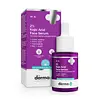What's inside
What's inside
 Key Ingredients
Key Ingredients

 Benefits
Benefits

 Concerns
Concerns

No concerns
 Ingredients Side-by-side
Ingredients Side-by-side

Water
Skin ConditioningPropanediol
SolventEthoxydiglycol
HumectantGlycereth-26
HumectantAlpha-Arbutin
AntioxidantPanthenol
Skin ConditioningKojic Acid
AntioxidantPhenoxyethanol
PreservativeEthylhexylglycerin
Skin ConditioningHamamelis Virginiana Extract
AntiseborrhoeicAmmonium Acryloyldimethyltaurate/Vp Copolymer
Disodium Hydroxyethyliminodiacetate
Sodium Hyaluronate
HumectantCamellia Sinensis Leaf Extract
AntimicrobialHydroxyethylcellulose
Emulsion StabilisingWater, Propanediol, Ethoxydiglycol, Glycereth-26, Alpha-Arbutin, Panthenol, Kojic Acid, Phenoxyethanol, Ethylhexylglycerin, Hamamelis Virginiana Extract, Ammonium Acryloyldimethyltaurate/Vp Copolymer, Disodium Hydroxyethyliminodiacetate, Sodium Hyaluronate, Camellia Sinensis Leaf Extract, Hydroxyethylcellulose
Water
Skin ConditioningPropanediol
SolventEthoxydiglycol
HumectantKojic Acid
AntioxidantNiacinamide
SmoothingPentylene Glycol
Skin ConditioningAlpha-Arbutin
AntioxidantDimethyl Isosorbide
SolventGlycerin
HumectantEpigallocatechin Gallatyl Glucoside
AntioxidantSodium PCA
HumectantPanthenol
Skin ConditioningSodium Hyaluronate
HumectantAstragalus Gummifer Gum
Emulsion StabilisingHydroxypropyl Methylcellulose
Emulsion StabilisingPhenoxyethanol
PreservativeCaprylyl Glycol
EmollientEthylhexylglycerin
Skin ConditioningTrisodium Ethylenediamine Disuccinate
Proline
Skin ConditioningHydroxyproline
Skin ConditioningCI 19140
Cosmetic ColorantWater, Propanediol, Ethoxydiglycol, Kojic Acid, Niacinamide, Pentylene Glycol, Alpha-Arbutin, Dimethyl Isosorbide, Glycerin, Epigallocatechin Gallatyl Glucoside, Sodium PCA, Panthenol, Sodium Hyaluronate, Astragalus Gummifer Gum, Hydroxypropyl Methylcellulose, Phenoxyethanol, Caprylyl Glycol, Ethylhexylglycerin, Trisodium Ethylenediamine Disuccinate, Proline, Hydroxyproline, CI 19140
Ingredients Explained
These ingredients are found in both products.
Ingredients higher up in an ingredient list are typically present in a larger amount.
Alpha-Arbutin is made from hydroquinone and glucose. It may also be derived from the fermentation of soybeans.
This ingredient an antioxidant, meaning it helps protect your skin cells against damage.
Studies show this ingredient helps improve hyperpigmentation and fade discoloration.
Alpha-Arbutin may be used with other ingredients that help with hyperpigmentation. These ingredients include retinol, Vitamin C, niacinamide, and tranexamic acid.
Learn more about Alpha-ArbutinEthoxydiglycol is a synthetic solvent.
Solvents are used to keep ingredients together in a product. They can help dissolve ingredients to stable bases or help evenly distribute ingredients throughout the product.
Ethoxydiglycol also helps deliver other key ingredients into the skin.
Learn more about EthoxydiglycolEthylhexylglycerin (we can't pronounce this either) is commonly used as a preservative and skin softener. It is derived from glyceryl.
You might see Ethylhexylglycerin often paired with other preservatives such as phenoxyethanol. Ethylhexylglycerin has been found to increase the effectiveness of these other preservatives.
Kojic acid comes from fungi and can also be from fermented foods. It helps even out skin tone and reduce hyperpigmentation.
This ingredient works by blocking tyrosine, an enzyme that starts the process of skin darkening.
Kojic Acid is antifungal and often used to treat fungal infections. Additionally, it can help fight bacteria with its antimicrobrial properties. This can help treat acne as well.
A similar ingredient is arbutin.
Learn more about Kojic AcidPanthenol is a common ingredient that helps hydrate and soothe the skin. It is found naturally in our skin and hair.
There are two forms of panthenol: D and L.
D-panthenol is also known as dexpanthenol. Most cosmetics use dexpanthenol or a mixture of D and L-panthenol.
Panthenol is famous due to its ability to go deeper into the skin's layers. Using this ingredient has numerous pros (and no cons):
Like hyaluronic acid, panthenol is a humectant. Humectants are able to bind and hold large amounts of water to keep skin hydrated.
This ingredient works well for wound healing. It works by increasing tissue in the wound and helps close open wounds.
Once oxidized, panthenol converts to pantothenic acid. Panthothenic acid is found in all living cells.
This ingredient is also referred to as pro-vitamin B5.
Learn more about PanthenolPhenoxyethanol is a preservative that has germicide, antimicrobial, and aromatic properties. Studies show that phenoxyethanol can prevent microbial growth. By itself, it has a scent that is similar to that of a rose.
It's often used in formulations along with Caprylyl Glycol to preserve the shelf life of products.
Propanediol is an all-star ingredient. It softens, hydrates, and smooths the skin.
It’s often used to:
Propanediol is not likely to cause sensitivity and considered safe to use. It is derived from corn or petroleum with a clear color and no scent.
Learn more about PropanediolSodium Hyaluronate is hyaluronic acid's salt form. It is commonly derived from the sodium salt of hyaluronic acid.
Like hyaluronic acid, it is great at holding water and acts as a humectant. This makes it a great skin hydrating ingredient.
Sodium Hyaluronate is naturally occurring in our bodies and is mostly found in eye fluid and joints.
These are some other common types of Hyaluronic Acid:
Learn more about Sodium HyaluronateWater. It's the most common cosmetic ingredient of all. You'll usually see it at the top of ingredient lists, meaning that it makes up the largest part of the product.
So why is it so popular? Water most often acts as a solvent - this means that it helps dissolve other ingredients into the formulation.
You'll also recognize water as that liquid we all need to stay alive. If you see this, drink a glass of water. Stay hydrated!
Learn more about Water